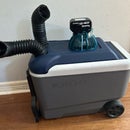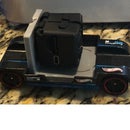Introduction: Kayak Stand
I just finished this last weekend. It's just a simple wooden kayak stand composed of a frame pivoting on 7/8" dowels and supporting four nylon straps. The process can be easily replicated using a hardboard template.
I used router table to round over the edges of the "paddles" to make them look a little more authentic. With a jig saw, drill, router and template bit this can be finished in a day.
I used router table to round over the edges of the "paddles" to make them look a little more authentic. With a jig saw, drill, router and template bit this can be finished in a day.
Step 1: Gather the Materials
What you'll need:
1 - 2' X 4" 1/4" hardboard for the template ~$5.00
4 - 18" long 1" nylon straps Free
2 - 36" hardwood dowels $3.50
6- 36" 1" X 4" (I used "super strips from the Home Depot which are 1-1/16" thick) $2.97 for 8'
Tools:
7/8" Drill bit (or the same size as your dowels)
Drill (a drill press is best if you can't drill a straight hole to save your life)
Stapler or hammer/tacks
Jig saw (bandsaw, scroll saw)
Template router bit
1/4" Roundover bit
Router (a router table is best)
Pencil
Scissors
Wood Glue (use Gorilla glue or something similar for an outdoor kayak stand)
Step 2: Design the Paddles
The first step is to design the paddles. You don't need CAD, just draw out a symetrical shape that will form the basis for your design. You can just as easily draw one half then trace that and the mirror image onto the hardboard template. You can print out the drawing below full scale at Kinko's for about $5.
If you are free handing the template, roughly sketch out the design then trace pots, pans, coffee lids or anything else that is round to smooth the shapes. All of the paddles will look exactly like this one, so don't rush.
If you are free handing the template, roughly sketch out the design then trace pots, pans, coffee lids or anything else that is round to smooth the shapes. All of the paddles will look exactly like this one, so don't rush.
Step 3: Cut the Templates
After you are happy with your design, cut out the templates with your jig saw. If it isn't a tool you use frequently, take your time and trim slightly outside of your line. You can use a sander or even the router table to finish the cuts and bring them right up to the line.
There is no need to drill the hole for the dowel yet, just cut out the template.
There is no need to drill the hole for the dowel yet, just cut out the template.
Step 4: Cutting Out/machining the Legs
The template needs to be attached to each leg for routing. Sleighbed.net has a pretty good description of this(at the bottom). You can use nails, but small screws will work better since you only have the one template (the hardboad will be difficult to get the nails out of). Attach the template to the board, cut off all material leaving a 1/8"-3/16" margin all the way around the template.
This picture is for a sleighbed leg, but you can see the bit and the templates and how the process works.
Repeat this for all of the legs. Make sure to attach the screws somewhere that minimizes their visibility. The spots where the dowels will be attached is best. It needs to be very secure before being placed on the router table!
Template Maching Link
This picture is for a sleighbed leg, but you can see the bit and the templates and how the process works.
Repeat this for all of the legs. Make sure to attach the screws somewhere that minimizes their visibility. The spots where the dowels will be attached is best. It needs to be very secure before being placed on the router table!
Template Maching Link
Step 5: Drill the Holes
The kayak stand I saw that spawned this idea used angled legs for more strength and stability. Drilling multiples holes on an angle is a pain. I risked it, and it seems to have worked out fine. The key is to make certain the holes you drill are as close as possible to the dowel you purchased. Don't try to use closet poles of some other cheap dowels. These often aren't even close to round. A forsner bit is best, but a spade bit will work.
Drill your first hole in the template. You can use it as a setup piece, or clamp it to the finished pieces to use as a guide. Drill a hole in a scrap piece and test your dowel. It doesn't have to be incredibly tight, but if it wabbles, your kayak will end up on the ground!
The design I used is symmetrical. Lowering or raising the pivot point for the legs will decrease or increase the footprint of the stand and make it less or more stable. With three points of contact, the stand is very stable with the centered holes, but raising the holes slightly higher would make it more stable still.
Drill your first hole in the template. You can use it as a setup piece, or clamp it to the finished pieces to use as a guide. Drill a hole in a scrap piece and test your dowel. It doesn't have to be incredibly tight, but if it wabbles, your kayak will end up on the ground!
The design I used is symmetrical. Lowering or raising the pivot point for the legs will decrease or increase the footprint of the stand and make it less or more stable. With three points of contact, the stand is very stable with the centered holes, but raising the holes slightly higher would make it more stable still.
Step 6: Rounding Over and Sanding
After all of the holes have been drilled and checked, Roundover and sand all of the the legs. I used 220 grit because I finished the stand with a poly-urethane. If you are planning to paint or let the stand weather, 80 or 120 will be fine. Rounding over is just an aesthetic detail, but it really dresses it up!
Step 7: Gluing/Finishing
If you haven't used the glue like Gorilla glue before, here is a tip. WEAR GLOVES. It will stain your hands and you will not be able to wash it off. The glue reacts with the water in the two surfaces and foams to provide a solid joint.
My center holes were a little bit wide for the dowel. All four holes in the outer legs were very tight. I dampened the holes with a sponge, and the dowel then spread the glue evening in the hole and on the dowel. To mitigate the center hole problem, I wet the dowel and and spread a thin layer of glue all the way around. Then I centered the middle leg on the dowel. Don't forget to move the center leg as the glue sets up to make sure it doesn't get stuck in one place! It worked perfectly, the leg moves with just a little bit of friction.
Make sure to line up the two sets of stands to ensure they are parallel. So long as the dowels are cut to the same length, any necessary adjustment will be very minimal, but the boards used may have a bit of warp or twist.
After the glue dries you will notice white-yellowish foam around the joints. I used a kitchen knife to scrap off the larger spots before touching up the sanding one last time.
If you are planning to finish the stand as I did, make sure you use a tack cloth. They are in the paint section and are about 3" square. The expand out to about 18" square and are basically stickly cheese cloth. This will get all of the dust off the parts and give you a very smooth finished.
I put three coats with light sanding in between each coat.
My center holes were a little bit wide for the dowel. All four holes in the outer legs were very tight. I dampened the holes with a sponge, and the dowel then spread the glue evening in the hole and on the dowel. To mitigate the center hole problem, I wet the dowel and and spread a thin layer of glue all the way around. Then I centered the middle leg on the dowel. Don't forget to move the center leg as the glue sets up to make sure it doesn't get stuck in one place! It worked perfectly, the leg moves with just a little bit of friction.
Make sure to line up the two sets of stands to ensure they are parallel. So long as the dowels are cut to the same length, any necessary adjustment will be very minimal, but the boards used may have a bit of warp or twist.
After the glue dries you will notice white-yellowish foam around the joints. I used a kitchen knife to scrap off the larger spots before touching up the sanding one last time.
If you are planning to finish the stand as I did, make sure you use a tack cloth. They are in the paint section and are about 3" square. The expand out to about 18" square and are basically stickly cheese cloth. This will get all of the dust off the parts and give you a very smooth finished.
I put three coats with light sanding in between each coat.
Step 8: Attach Straps, Use Stand
I attached the straps with staples wrapping the strap fully around the staple one rotation to make sure only the nylon came in contact with the kayak. It has the added benefit as acting as a stop in case the staple works itself loose, the weight of the kayak and the friction between the straps will keep it from slipping.
On my stands, there are two straps on each stand. The middle leg has a dowel extending just about 1" on each side of the leg that is parallel to the full width dowel held by the opposing legs. Realistically, one strap will probably be fine, but I had already drilled all of the legs with the hole in the top for the dowel when I came to that conclusion.
Before putting the weight of the kayak on the stands, make sure not of the legs wobble on the dowels. If there is still a wobble, reglue that portion. I did not use any mechanical fasteners on the legs, just the glue.
Setup and enjoy.
On my stands, there are two straps on each stand. The middle leg has a dowel extending just about 1" on each side of the leg that is parallel to the full width dowel held by the opposing legs. Realistically, one strap will probably be fine, but I had already drilled all of the legs with the hole in the top for the dowel when I came to that conclusion.
Before putting the weight of the kayak on the stands, make sure not of the legs wobble on the dowels. If there is still a wobble, reglue that portion. I did not use any mechanical fasteners on the legs, just the glue.
Setup and enjoy.




